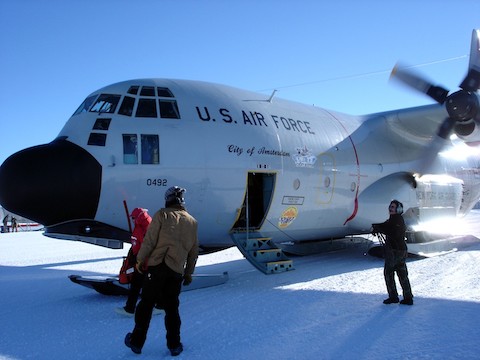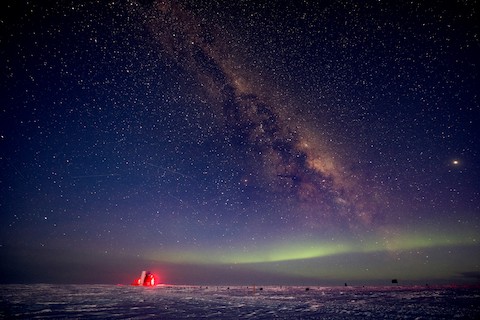
The South Pole is the most inhospitable place on Earth—yet, each year, around 50 brave scientists and staff endure the winter there. Outside temperatures approach minus 120 degrees Fahrenheit in constant darkness.
And they better hope nothing goes wrong. Because no one can come to help them.
The South Pole is 800 miles from the nearest human contact. That’s farther than the International Space Station, which orbits less than 400 miles above Earth.
From research bases on the Antarctic coast, it takes planes 5 to 8 hours to fly to the South Pole. But it’s so cold in winter that jet fuel turns to slush, meaning no flights can come or go.
An over-land caravan of snow tractors in the summer takes 40 days.
The sun is up in summer for more than 4,000 hours, one six-month-long day. At that time, the South Pole research station has its highest population, 200 scientists and staff. They study solar spots and atmospheric ozone, cosmic rays and neutrinos.
Low temperatures still average negative 20 degrees Fahrenheit.
In the fall, the sun nears the horizon for six weeks of dusk. Then it sets and is gone for three months for that seemingly endless night that is Antarctic winter.
It takes a special person to endure the isolation, darkness, danger and lethal cold.
Background
Synopsis: During the Southern Hemisphere winter, a few dozen people spend the polar night in total isolation at the Amundsen–Scott South Pole Station. That means nine months at 1.75 mi (2.8 km) elevation in one of the coldest places on Earth from February to November with no way out. Farther from civilization than the International Space Station, the workers manage year-round scientific experiments and keep the facilities running until the sun warms the base enough that jet fuel doesn’t freeze and summer activities can begin.
- During the summer (October to February), 150–200 people work at the Amundsen–Scott South Pole Station, but, during the winter, the population drops to around 50 facility managers and scientists. The National Science Foundation manages the station.
- The geographic South Pole, at 90 south latitude, is the southernmost point around which Earth rotates on its axis, located on the continent of Antarctica.
- Experiments range from solar phenomena and atmospheric ozone studies to cosmic ray and neutrino detectors.
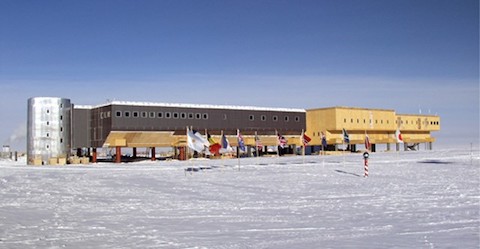
- Every year the South Pole has only one day and one night.
- The South Pole has six continuous months of daylight followed by six months when the sun stays below the horizon, transitioning from dusk into night then finally into dawn.
- Three months of total darkness occur from mid-May through the end of July.
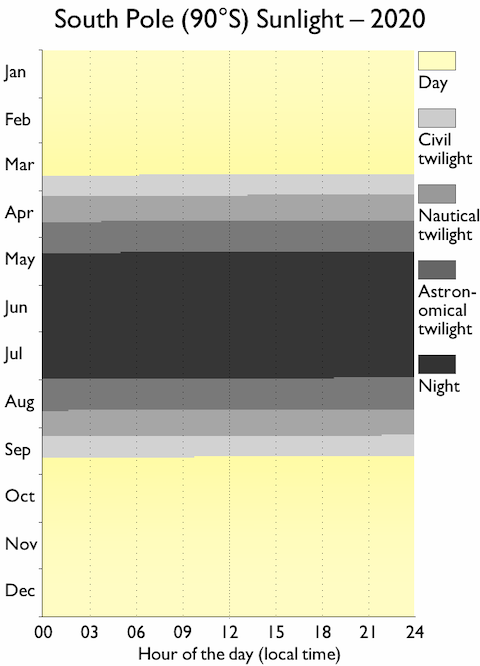
- The South Pole is the coldest pole, registering temperatures far colder than the North Pole.
- Neither pole gets direct sunlight, but they do get about the same amount.
- The North Pole is in the middle of the Arctic Ocean, and liquid water is warmer than ice, so the North Pole atmosphere is moderated by the sea.
- The South Pole is in the middle of the mountainous Antarctic continent surrounded by a frozen continent, which is home to many of the coldest places on Earth.
- The yearly average temperature at the South Pole Station is -56oF (-49oC) with recorded temperatures ranging from a balmy 7.5oF (-13.6oC) to a frigid -117oF (-82.8oC in June 1982), according to the National Science Foundation.
- Since cold air holds very little water vapor, the continent is also home to some of the driest places on Earth—polar deserts.
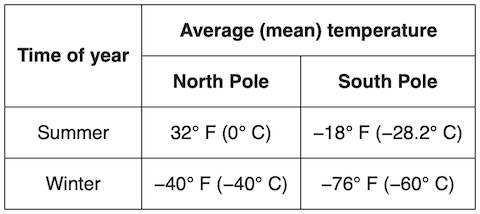
- In a previous episode (ED 142), we learned about the first explorers to reach the South Pole, including some tragic consequences of the extreme cold.
- Researchers recently found that he slipperiness of ice decreases at around -49oF (-45oC), with its coefficient of friction increasing as temperatures drop (ED-141).
- This phenomenon likely caused the demise of the British Antarctic Expedition of 1910 as their sleds stopped sliding on the ice when temperatures plummeted.
- This same effect could adversely impact modern activities at the pole.
- In its position on a high desert plateau, the South Pole has an elevation of more than 1.75 mi (9,306 ft or 2,835 m), accentuating the cold.
- The ice sheet is about 9,000 ft (2,700 m) thick at the South Pole Station and moves about 33 ft (10m) per year, requiring the staff to move the marker regularly.
- The South Pole elevation compares with high elevation cities like Ecuador’s mountainous capital Quito and with American ski towns like Taos, New Mexico and Silverton, Colorado.
- Without gradual acclimation, altitude sickness tends to occur above 8,000 ft (2,400 m) because of reduced air pressure and lower oxygen levels.
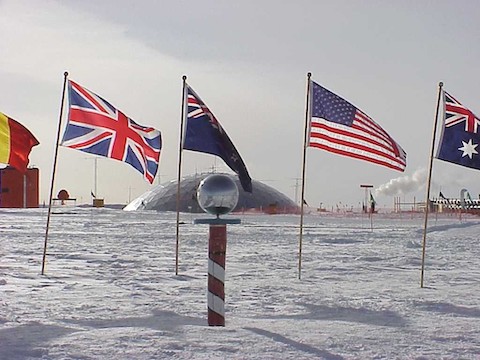
- At 764 mi (1,230 km) from the nearest coast, the Amundsen–Scott South Pole Station is isolated.
- China’s Dome Argus is the closest summer research station that is 665 mi (1,070 km) away and Russia’s Vostok Station is the closest permanently staffed research station at 800 mi (1,290 km) away as the crow flies.
- That makes the South Pole Station farther from other humans than the International Space Station that orbits Earth at about 250 mi (400 km).
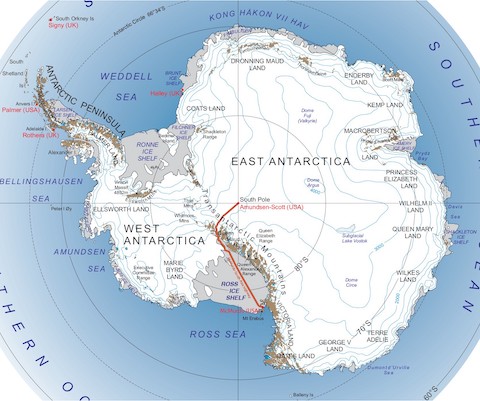
- From February to November each year, the South Pole station is inaccessible by land or air.
- In summers, a 40-day caravan moves cargo to the South Pole from the United States McMurdo Station near the coast via the South Pole Overland Traverse.
- The Traverse rises more than 9,250 ft (2,820 m) to link McMurdo Station on the Ross Ice Sheet coast with the Amundsen–Scott South Pole Station on the Antarctic Plateau at 9,301 ft (2,835 m) elevation.
- Earth’s southernmost road is a 995-mile-long (1,600 km) flagged ice and packed snow route constructed by filling in deep crevasses with packed snow. It requires annual maintenance to repair damage caused by the mobile ice sheets that cross its path.
- Air travel to the Amundsen–Scott South Pole Station only occurs from November to February depending on the temperature.
- The flights from McMurdo Station take five to eight hours and land on a packed 12,000 ft (3,658 m) long snow skiway with the airport code NZSP.
- The jet fuel used in the military aircraft that fly to the station turns to a gel at -76oF (-60oC), so aircraft don’t fly at temperatures below -58oF (50oC).
- Additionally, the materials in the aircraft become stiff and fragile at these temperatures, so parts break easily.
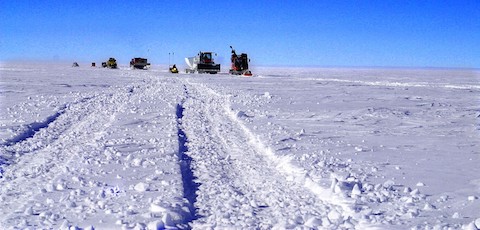
- However, this year tourists can visit the South Pole on flights originating from a base on Antarctica’s Union Glacier in the summer of 2021/2022 for a very cool $51,250 each!
